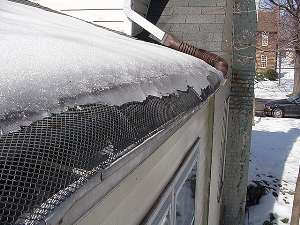Ice dams |
|
Ice dams can cause tremendous damage. Ice dams are caused by a loss of heat from the living space which heats the deck of the roof. This heat melts the snow higher up on the roof. This water trickles down to the lower part of the roof which is less affected by heat loss from the living space. Here, it refreezes and begins to build. The best way to deal with ice dams is to prevent them. |
 |
|
Items needed:
Depends
|
Safety Suggestions and Tips
Wear safety glasses |
Level of difficulty
 Time Required: 1 hour
|
|
|
|
Steps |
|
|
|
|
Step 1: Ice dams are caused by a loss of heat from the living space to the roof deck. They can cause water to leak into walls and damage paint and drywall. Inspect the attic. Look to make sure that the gap between the insulation and the roof deck is clear. Check to make sure that any openings from the living space to the attic (bypasses) are sealed. You can use foam or caulk to seal these air leaks. Also make sure that the insulation covers as much area as possible. Don't cover lights unless they are rated for it but make sure that other things (plumbing and wiring) don't displace insulation. |
|
Step 2: If the insulation is blocking the air vents at the soffits, you may need to install baffles. If you have soffit vents, you need to make sure that they are clear. If you have icing problems you may need to install more vents. Some vents are small 1 or 2" round affairs but on more modern construction the vents are built into the siding. |
|
Step 3: Now that the soffits are clear, you need to make sure that the warm air has a place to go at the ridge. Normal vents include ridge, gable and powered vents. Make sure that these vents are clear and operating properly. Most powered vents only work in the summer so make sure that your other vents are clear. |
|
Step 4: If all of your vents are clean, you may need more insulation. Most houses have about 12" of insulation in the attic. A common problem is the lack of space near the edge (soffit) of the roof. Many times this area is only 6" or so tall, if this is the case, you may need to use a different type of insulation that has a higher "R" value than standard fiberglass. Some insulating foams and high-density fiberglasses are appropriate for this. |